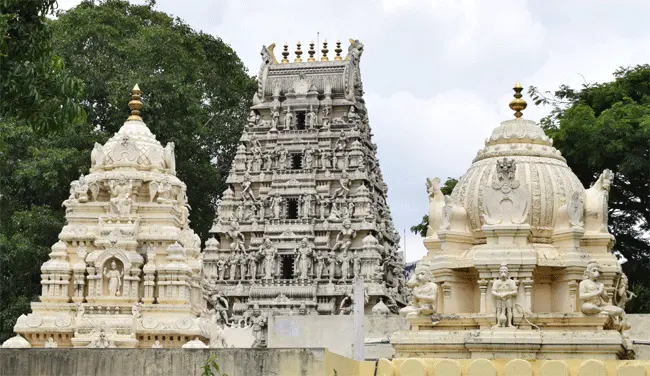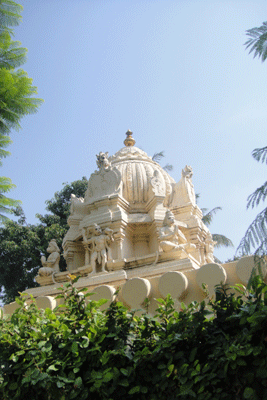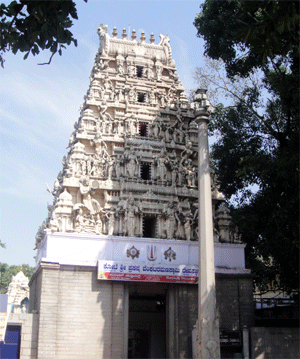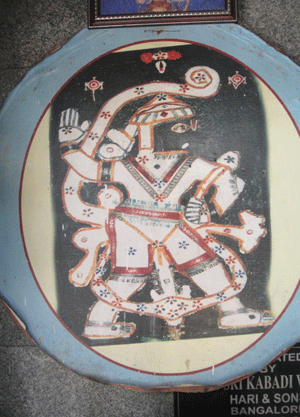
Fort of Bangalore
Hiriya Kempe Gowda (c 1513-1569, c 1510-1570 AD) is also called Kempe Gowda, Kempe Gowda I, or Bengalooru Kempe Gowda, built up Bangalore as his capital city. On an auspicious day in 1537, he conducted a groundbreaking ritual and festivities by plowing the land with four pairs of decorated white bulls in four directions. After that, he constructed a mud fort with a moat surrounding it and nine large gates.
After him, Immadi Kempe Gowda (Kempe Gowda II) came to power in 1585. Kempe Gowda II was also credited with the erection of four towers (Shikharas) at the four corners of Bangalore (Bangalore copper plate 1597), which are said to be the limit to which Bangalore would extend.
 Rustom-i-Zaman, the commander under the Bijapur Sultanate, was to take on Kempe Gowda II. But Kasturi Ranga Nayak of Sira and friend of Kempa Gowda prevailed on him to surrender the fort with all its riches without any battle. Rustom-i-Zaman then took over the fort and handed over its management to Shahji [father of Sivaji] along with other territories, which he had recently conquered, with Bangalore as his headquarters. In 1687, the Mughal general Kasim Khan, under orders from Aurangzeb, defeated Ekoji I, son of Shāhji, and sold Bangalore to Chikkadevaraja Wodeyar (1673–1704), the then ruler of the Kingdom of Mysore for three lakh rupees.
Rustom-i-Zaman, the commander under the Bijapur Sultanate, was to take on Kempe Gowda II. But Kasturi Ranga Nayak of Sira and friend of Kempa Gowda prevailed on him to surrender the fort with all its riches without any battle. Rustom-i-Zaman then took over the fort and handed over its management to Shahji [father of Sivaji] along with other territories, which he had recently conquered, with Bangalore as his headquarters. In 1687, the Mughal general Kasim Khan, under orders from Aurangzeb, defeated Ekoji I, son of Shāhji, and sold Bangalore to Chikkadevaraja Wodeyar (1673–1704), the then ruler of the Kingdom of Mysore for three lakh rupees.
First Palace of Mysore maharajas at Bangalore
Now that Bangalore was under the rule of the Mysore kingdom, the mud fort was enlarged during Chikkadeva Raya Wodeyar's rule. In 1689, the fort was expanded in the southward direction. The first thing, he had built was a temple for Sri Venkateswara and a palace next to it within the fort boundaries.
Today the temple in Krishnarajendra Road is known as ‘Kote Venkataramana Temple’. Kanthirava Narasaraja II, the son of Chikkadeva Raya had made huge grants to this temple showing the importance the Mysore Royals had attached to this temple.
Today what is popularly known as ‘Tippu Summer Palace’, located adjacent to Kote Venkataramana Temple was originally built as a palace by Mysore rulers. [Ref:Michell, George (1995) [1995]. The New Cambridge History of India].
If the Mysore Royals had been living in the palace, they must have been visiting the temple regularly. The path connecting the Palace with the temple is shown by the Google map. In the old map the area had been shown as a ‘parade.’ Keeping in mind that the drawing was made nearly a hundred years later, the open space in the eastern of the palace had been converted into a parade ground as per the needs of that day.
Therefore the temple is a part of the summer palace of the Mysore rulers. It could be seen today in Mysore, that there are many temples built by various rulers of Mysore within the palace complex. The practice could be further traced to many palaces of old rulers of Vijayanagara leaning.
Mysore Gate of Fort of Bangalore
 From the old maps, it could be observed that the fort was oval. The fort had Delhi Gate facing the pettah of Bangalore and Mysore Gate in the south as per the maps. The summer palace and the temple of Sri Venkataramana are adjacent to the Mysore Gate. In all probability, the Royals should have been then using this gate for entry as could be seen that the first sight of the Royals will be that of Lord Venkateswara temple will be a good omen.
From the old maps, it could be observed that the fort was oval. The fort had Delhi Gate facing the pettah of Bangalore and Mysore Gate in the south as per the maps. The summer palace and the temple of Sri Venkataramana are adjacent to the Mysore Gate. In all probability, the Royals should have been then using this gate for entry as could be seen that the first sight of the Royals will be that of Lord Venkateswara temple will be a good omen.
A close look at the old map and the present map from Google of the area encompassing Kote Venkataramana Temple and Summer Palace, it could be observed that both are more or less tallying.
Entry to Sri Venkataramana Temple
If the Royals had been living in the palace, they must have been visiting the temple regularly. The path connecting the Palace with the temple is shown by the Google map. In the old map, the area had been shown as a ‘parade.’ Keeping in mind that the drawing was made nearly a hundred years later, the open space in the eastern of the palace had been converted into a parade ground as per the needs of that day. If the Royals had been entering into the temple from the south, the first deity they would have worshiped would be Sri Anjaneya. It is customary for all the Royals, following the Vijayanagar tradition to worship Sri Anjaneya first as they believe that he is the guardian deity of any establishment.
Sri Anjaneya Sannidhi
 It is located in the south-west corner of the Sri Venkatramana Temple complex. Although one cannot enter the Temple complex from the Summer Palace today, the sannidhi of Sri Anjaneya can be seen from the Summer Palace. Today there is a wall separating the temple complex and summer palace. In the olden days Royals might have been entering the temple as palace and temple were not separated. Today the devotee enters through the rajagopuram facing east. The rajagopuram was added in 1978. Three main sannidhis of the temple are Sri Anjaneya in the southwest, Sri Venkataramana in garbhagraham, and Sri Mahalakshmi in the northeast. In the southwest corner of the complex, Sri Anjaneya sannidhi faces east. The idol of the deity is made of a single black granite stone and ‘embossed’, called ‘ardha-shila’. Chakkra and conch are seen on both sides of the idol.
It is located in the south-west corner of the Sri Venkatramana Temple complex. Although one cannot enter the Temple complex from the Summer Palace today, the sannidhi of Sri Anjaneya can be seen from the Summer Palace. Today there is a wall separating the temple complex and summer palace. In the olden days Royals might have been entering the temple as palace and temple were not separated. Today the devotee enters through the rajagopuram facing east. The rajagopuram was added in 1978. Three main sannidhis of the temple are Sri Anjaneya in the southwest, Sri Venkataramana in garbhagraham, and Sri Mahalakshmi in the northeast. In the southwest corner of the complex, Sri Anjaneya sannidhi faces east. The idol of the deity is made of a single black granite stone and ‘embossed’, called ‘ardha-shila’. Chakkra and conch are seen on both sides of the idol.
Palace Sri Anjaneya
Sri Anjaneya is seen walking northward, with His left lotus foot forward. On both legs, he is seen wearing a hollow anklet and nupuram [an ornamental chain with small balls hanging]. Near the left knee, he is seen wearing an ornamental chain. He is seen wearing dothi in kacham style. An ornamental waist belt is holding the dothi and adding beauty to the waist. His left hand is seen holding the stem of the ‘sowgandhika’ flower and resting on His left Hip. The flower is seen near His left shoulder as if ready to flower and spread fragrance. His right hand is raised above His right shoulder showing the ‘abhaya mudra’. His Bosom is adorned with chains and in one of them, a pendent with Sri Rama, Sita, and Lakshmana is seen. Neatly braided sikka is seen with a knot over His right shoulder. The ornamental ‘sikka-mani’ [hair-band] is holding the hair firmly. His glowing high cheeks and slightly jutted mouth add beauty to Sundaram. The radiant eyes assure the devotees' fearlessness and bless calm and valor at the same time.
Location of the temple: "Palace Anjaneya, Krishnarajendra Road, Bangalore"
Experience
The Lord, who bestowed Chikkadeva Raya Wodeyar all qualities to re-establish a righteous rule is sure to give all qualities to the devotee when the intentions of prayer are for a righteous cause.
SRI HANUMAN THINKS DIFFERENTLY, THINKS FAST
THINKS AHEAD AND ACTS FOR SURE
Ed [December 2019 [Sri Hanumath Jayanthi spl]
Updates: [Jan 2025]
